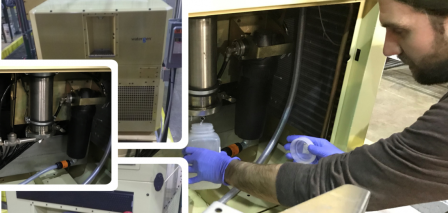Atmospheric Water Generation Research
Evaluating technologies that produce potable water from the air
Atmospheric water generation (AWG) uses technology to produce potable water from surrounding air. This provides the potential to expand water availability during shortages, contamination events, and other issues that can interrupt drinking water services. Natural disasters, such as hurricanes, and public water infrastructure failures, such as pipe corrosion resulting in contamination issues, have increased the interest in AWG technology as both emergency and long-term supply solutions.
Atmospheric Water Generators
AWG generators range from home-based units that can produce 1 to 20 liters of water per day to commercial-scale units capable of 1,000 to over 10,000 liters per day. Water production rates are highly dependent upon the air temperature and the amount of water vapor (i.e., humidity) in the air. The most commonly used AWG systems employ condenser and cooling coil technology to pull moisture from the air in the same way a household dehumidifier does. Although significant quantities of energy can be required to operate these condenser and fan systems, recent technological advancements have substantially improved the energy-water ratio—increasing the feasibility of using these systems to help augment the Nation’s drinking water resources.
Cooperative Research Partnership
In September 2017, EPA’s Office of Research and Development announced a new Cooperative Research and Development Agreement (CRADA) to further advance the science of AWG and assess its potential as a water production and supply solution. Specifically, EPA signed a CRADA with Watergen to evaluate their GEN-350 system. Watergen is a corporation developing cutting-edge AWG technology. The GEN-350 can generate nearly 600 liters of water per day in optimal temperature and humidity conditions. (Infomation about WatergenExit)
Research and Evaluation
 Scientist evaluating the microbial quality of untreated condensate from a commercial atmospheric water generator during a three-month study. A Watergen AWG test unit was evaluated at one of EPA’s laboratry facilities for collaborative research purposes. Although high quality water is anticipated from SWG units, volatile organic compounds in the air can dissolve in the condensate, providing a food source for microbial growth in plumbing and stored water. An initial review of water quality data provided by Watergen confirmed both the generally high quality of produced water (e.g., no elemental analyses above current EPA drinking water standards), and an elevated level of overall microbial numbers, as defined by heterotrophic plate counts (HPC). The HPC method provides an overall estimate of colony forming heterotrophic bacteria in water. Indicators of fecal contamination, such as fecal coliforms and Escherichia coli, were not detected.
Scientist evaluating the microbial quality of untreated condensate from a commercial atmospheric water generator during a three-month study. A Watergen AWG test unit was evaluated at one of EPA’s laboratry facilities for collaborative research purposes. Although high quality water is anticipated from SWG units, volatile organic compounds in the air can dissolve in the condensate, providing a food source for microbial growth in plumbing and stored water. An initial review of water quality data provided by Watergen confirmed both the generally high quality of produced water (e.g., no elemental analyses above current EPA drinking water standards), and an elevated level of overall microbial numbers, as defined by heterotrophic plate counts (HPC). The HPC method provides an overall estimate of colony forming heterotrophic bacteria in water. Indicators of fecal contamination, such as fecal coliforms and Escherichia coli, were not detected.
Research Goal
The goal of the research study under the CRADA was to evaluate the microbial quality of untreated condensate and produced treated water from a Watergen GEN-350 unit during three months of continuous operation. In the absence of disinfection substances/system there can be microorganisms as determined by HPC. These microorganisms may not represent a direct human health risk, but positive HPC results suggest favorable conditions for microbial growth. The primary microorganisms of human health concern are opportunistic pathogens that can grow in drinking water infrastructure, such as Legionella spp. and Mycobacterium spp.
Research Results and Conclusions To-Date
Neither Legionella nor Mycobacteria were detected in weekly samples. However, EPA testing confirmed high HPC results in both treated and untreated waters. All test results indicated that the water produced by Watergen’s GEN-350 is microbiologically safe for human consumption. Watergen has acknowledged the need for further disinfection to reduce the risk of microbial growth. They offer a disinfection process unit as part of an overall solution for the GEN-350 treatment train. The unit is intended for long–term water preservation.
Future Research
EPA is interested in evaluating AWG units from other vendors.
Disclaimer: Any mention of or reference to commercial products, processes, or services by trade name, trademark, manufacturer, or otherwise does not imply an endorsement by the U.S. Government or the U.S. Environmental Protection Agency and shall not be used for advertising or product endorsement purposes. EPA does not endorse any commercial products, services, or enterprises.
